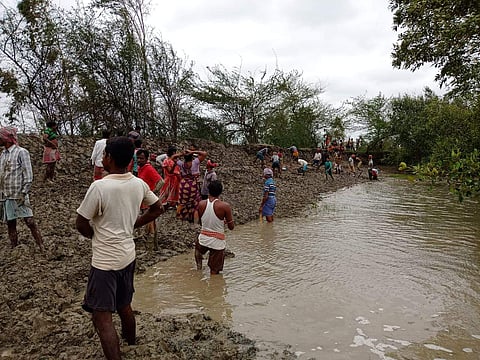

Shibe, a fisherman in Satjelia Island in Sundarbans, took his cows and goats to the local school a couple of days ago. He and his fellow villagers, Bhola Poira, a mechanic, and Polu Khara, a farmer, had just received a warning - Super Cyclone Amphan will make landfall in Sundarbans on May 20, 2020. He, however, didn't leave his home and instead chose to brave the worst of the storm. "I can't leave my home empty. It will be robbed otherwise," Shibe said.
And then Amphan hit.
Hundreds of houses were levelled, asbestos roofs blew away and thatched ones were destroyed after the ferocious superstorm Amphan made landfall around 2.30 pm on Wednesday. Rajesh Kumar Shaw, who runs a backpackers' eco village on the island says that their efforts at improvement has receded by what he estimates is five years. "A portion of the village remains submerged. The embankments broke and destroyed the jetty, cowshed, temple and the main pathway leading up to the village," said Rajesh.
When I finally managed to reach them after trying for hours, Rajesh said that he and the villagers were strengthening the embankments, which had completely been destroyed. Saltwater from the river has entered the villages, damaging rice fields among other crops. "We are hoping that the embankments don't get destroyed again by the high tide," Rajesh said. The villagers started restrengthening the embankments in the morning when the low tide began.
The situation worsened around 5 pm on Wednesday as the intensity of the rain and storm increased. Several villagers had already taken shelter at the local school with their families. Those who didn't, rushed to take shelter as the storm intensified. "Some villagers even came to the eco village to take shelter around 7 pm on the terrace. The area around us flooded and the water flowed above the danger level. It had already begun destroying the embankments. Their houses were submerged by then and several destroyed," adds Rajesh. Another villager, Jyotsna Das said her house was completely destroyed. "The asbestos roof blew off when the wind intensified. The mud walls gave way and the floodwaters took my window away," Jyotsna said.
The ordeal continued till 10 pm with several villagers' cries being heard over the storm every time an embankment washed away and the water rose, said Rajesh. "Sometime in the night, the topmost part of the embankments broke and water from the sea entered the Datta river," said Rajesh, "The villagers started returning to their homes around 11.30 pm after their immediate fear of flooding and being washed away was quelled." Bhola, who returned home with his wife Jamuna, said, "If we didn't come back then, our houses would have been robbed. We have very little grain left. We can't lose that as well."
The cyclone couldn't have hit at a worse time. Several villagers were already staring at unemployment amid the COVID-19 crisis now have it worse with their lands and homes destroyed. "The gram panchayat is meeting to address the crisis and its response. But we are unsure how to maintain social distancing any longer when we have to work in close proximity to restrengthen the embankments and rebuild the village," said Rajesh.
